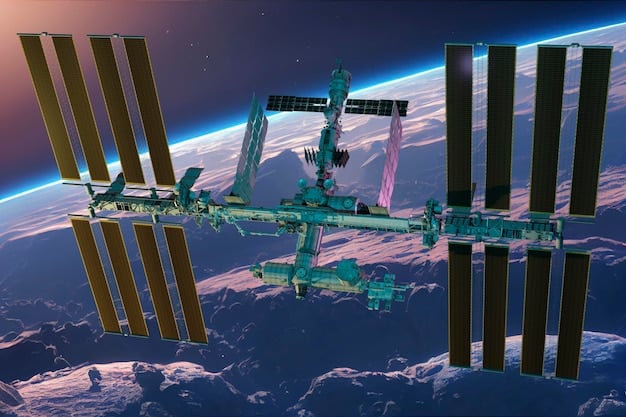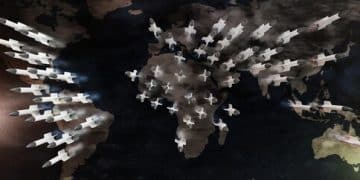The US Space Force: Mission and Global Security Impact

The US Space Force, established in 2019, aims to protect US assets and interests in space, ensuring freedom of operation for critical satellite systems vital for national security and global commerce, thereby significantly influencing geopolitical stability and military strategies worldwide.
In an era defined by rapid technological advancement and escalating geopolitical tensions, the very concept of warfare is expanding beyond terrestrial boundaries. Amidst this evolving landscape, The US Space Force: What is Its Mission and How Will It Impact Global Security? emerges as a critical entity, reshaping our understanding of defense and deterrence in the 21st century.
Understanding the US Space Force: Origins and Purpose
The establishment of the US Space Force in December 2019 marked a pivotal moment in American military history, creating the first new branch of the armed services since the Air Force was formed in 1947. This decision was not merely an administrative reshuffle but a strategic realignment reflecting the growing recognition of space as a critical domain for national security and economic prosperity. For decades, space operations were primarily housed within the US Air Force, but the accelerating pace of space militarization by potential adversaries necessitated a dedicated organization.
The primary impetus behind the Space Force’s creation was the undeniable reality that space, once perceived as a peaceful frontier for scientific exploration, had become a contested domain. Nations like China and Russia have been developing and testing anti-satellite (ASAT) weapons, demonstrating capabilities to disrupt, degrade, or destroy satellites in orbit. These developments pose an existential threat to the US’s reliance on space-based assets, which underpin virtually every aspect of modern military operations, from navigation and communication to intelligence gathering and precision targeting.
A New Frontier of Defense
The Space Force’s existence underscores a fundamental shift in defense strategy: protecting space assets is now as vital as maintaining air, land, or naval superiority. Its mission extends beyond mere defense, encompassing development, acquisition, and maintenance of military space capabilities, as well as recruitment and training of a specialized workforce known as “Guardians.”
- Deterrence in Space: The Space Force aims to deter aggression in space by demonstrating capabilities to respond to threats, ensuring that no adversary gains an uncontested advantage.
- Protecting Critical Infrastructure: Safeguarding US and allied satellites is paramount, as these assets provide essential services for military, civilian, and commercial applications.
- Dominance through Innovation: Fostering rapid acquisition of cutting-edge space technologies and systems to maintain a qualitative edge over competitors.
This organizational restructuring allows for a more focused approach, dedicating resources, expertise, and strategic thinking specifically to the unique challenges and opportunities presented by the space domain. Historically, space programs within the Air Force sometimes competed for resources with traditional air power priorities. The Space Force, as an independent branch, is designed to eliminate such competition and ensure space receives the prioritization it demands.
The origins of the Space Force are rooted in decades of evolving space policy and the recognition of an increasingly competitive space environment, culminating in a dedicated military service to meet the complex demands of the 21st-century space domain.
Core Missions and Responsibilities
The US Space Force’s operational mandate is multifaceted, extending far beyond simply launching satellites. Its core missions and responsibilities are designed to ensure the United States maintains its vital advantage in a domain increasingly critical to both national security and global stability. At its heart, the Space Force is tasked with organizing, training, and equipping forces to protect US and allied interests in space, provide space capabilities to the joint force, and ensure unfettered access to and freedom of operation in space.
One of the foremost responsibilities is Space Domain Awareness (SDA). This involves knowing what is happening in space, where things are, and what they are doing. SDA means tracking thousands of objects, from active satellites to space debris, to identify and characterize potential threats. Without robust SDA, the US would be blind to malicious activities or accidental collisions that could cripple its space infrastructure.
Key Operational Pillars
- Space Control: This pillar encompasses offensive and defensive operations to ensure US and allied freedom of action in space while denying adversaries the same. It includes capabilities to protect satellites from attack and, if necessary, disrupt an adversary’s space capabilities. However, such actions are highly sensitive due to the risk of creating more space debris or escalating conflicts.
- Space Force Application: Providing space-enabled capabilities to ground, air, and naval forces. This includes GPS for navigation and precision targeting, satellite communications (SATCOM) for global connectivity, and missile warning systems that rely on space-based sensors to detect launches. These capabilities are indispensable for modern military operations.
- Space Support: This involves launching and maintaining satellites, managing space ranges, and providing the necessary infrastructure to support all space operations. It ensures that critical assets are deployed, sustained, and upgraded as needed.
The Space Force also plays a crucial role in Intelligence, Surveillance, and Reconnaissance (ISR). Space-based sensors provide invaluable intelligence on adversary activities, troop movements, and missile capabilities, offering a global perspective unmatched by terrestrial systems. This data informs decision-making at the highest levels of government and military command.
Furthermore, the development and acquisition of new space technologies form a significant part of its responsibilities. This includes investing in next-generation satellites, ground systems, and launch capabilities that are more resilient, agile, and effective against evolving threats. The emphasis is on building a distributed and diversified constellation of satellites, making it harder for any single attack to cripple US space capabilities.

The Space Force’s mission extends to fostering a culture of innovation, attracting top talent, and collaborating with commercial space companies and international partners. The complexity of space operations demands a workforce with highly specialized skills in engineering, cybersecurity, and orbital mechanics. Moreover, international cooperation is vital for promoting responsible behavior in space and establishing norms that prevent conflict.
In essence, the core missions of the Space Force are to ensure the US’s continued access to space, protect its valuable assets, and deliver undisputed space capabilities to support joint force operations, effectively extending the sphere of national defense into Earth’s orbit and beyond.
The Global Impact on Security and Geopolitics
The creation and ongoing development of the US Space Force are sending ripple effects across the globe, profoundly impacting international security dynamics and reshaping geopolitical strategies. Its existence officially acknowledges space as a domain of potential conflict, prompting other nations to reassess and strengthen their own space capabilities. This shift signifies a departure from the historical notion of space as a peaceful frontier, ushering in an era of heightened competition and strategic maneuvering.
One of the most immediate impacts is the acceleration of the “space race” among major powers. While not a direct repeat of the Cold War’s scientific competition, this new race is decidedly military in nature. Nations like China and Russia are actively pursuing counter-space capabilities, including anti-satellite (ASAT) weapons, sophisticated jammers, and cyber warfare tools designed to disrupt or destroy space systems. The Space Force’s mission to deter such actions and defend US assets inevitably fuels a reactive arms buildup in orbit, raising concerns about space stability and the risk of orbital conflicts.
Escalation Risks and International Norms
The militarization of space carries inherent risks of escalation. A conflict that begins on Earth could easily extend into space, disrupting global communications, navigation, and intelligence gathering, with severe consequences for both military operations and civilian life. The destruction of satellites could also create vast amounts of orbital debris, rendering certain orbits unusable for decades, a scenario known as the “Kessler Syndrome.”
- Arms Control Challenges: The dual-use nature of many space technologies makes arms control agreements incredibly difficult to formulate and verify. A satellite capable of observation can also guide weapons, blurring the lines between peaceful and military applications.
- Blurred Lines of Conflict: An attack on a satellite in space might not neatly fit into traditional categories of armed conflict, complicating international responses and the application of international law.
- “Space Détente”: Some argue for the need for “space détente,” a period of reduced tensions and increased dialogue to establish norms of responsible behavior in space and prevent weaponization.
Geopolitically, the Space Force underscores a broader shift in power dynamics. Space capabilities are increasingly seen as a national power projection tool. Nations with sophisticated space infrastructure exert greater influence over global affairs, from military intelligence sharing to economic competitiveness. The US, with the Space Force, aims to retain its leadership in this critical domain, influencing allies and deterring adversaries.
Furthermore, the Space Force’s emphasis on partnerships—both with commercial space entities and international allies—also has significant geopolitical implications. By integrating commercial capabilities and fostering alliances, the US seeks to create a more resilient and distributed space architecture, enhancing collective security and sharing the burden of space defense. This collaborative approach can strengthen existing alliances and encourage new ones centered on space security.
In short, the US Space Force is not just a new military branch; it’s a profound declaration that space is the next strategic high ground. Its actions and developing capabilities will undoubtedly shape the future of international relations, potentially leading to both increased competition and, hopefully, greater efforts toward responsible space governance.
Technological Advancements and Future Capabilities
The very existence of the US Space Force is intrinsically linked to accelerating technological advancements, as it seeks to leverage cutting-edge innovations to maintain America’s strategic edge in orbit. The space domain is characterized by rapid evolution, from miniaturization and artificial intelligence to advanced propulsion and materials science, all of which are being integrated into the Space Force’s vision for future capabilities.
One of the most critical areas of focus is the development of next-generation satellite constellations. The traditional approach of deploying a few large, expensive, and relatively inflexible satellites is giving way to a concept of “resilient space architecture.” This involves deploying hundreds, or even thousands, of smaller, cheaper, and more agile satellites in low Earth orbit (LEO). Such a distributed network would be far more difficult for an adversary to disrupt or destroy, as the loss of a few satellites would not significantly degrade the overall system.
Innovations Driving Space Superiority
- Advanced Sensors and AI: Incorporating artificial intelligence and machine learning into space-based sensors to improve Space Domain Awareness, rapidly identify threats, and process vast amounts of data for intelligence gathering.
- On-Orbit Servicing and Assembly: Developing capabilities to refuel, repair, or upgrade satellites while they are in orbit, extending their lifespan and adaptability. This also opens the door to assembling large structures in space that are too big for a single rocket launch.
- Cybersecurity for Space Systems: Investing heavily in robust cybersecurity measures to protect satellites and ground control systems from sophisticated cyberattacks, which represent a low-cost, high-impact threat to space assets.
Beyond satellite technology, the Space Force is exploring innovative propulsion systems, including electric and nuclear propulsion, to enable faster transit times, more flexible orbital maneuvers, and extended mission durations for future spacecraft. These advancements are crucial for both defensive and offensive maneuvers in space, allowing satellites to evade threats or reposition for optimal performance.

The partnership with the booming commercial space industry is also a cornerstone of the Space Force’s technological strategy. Companies like SpaceX, Blue Origin, and Rocket Lab are driving down launch costs, accelerating innovation, and developing new capabilities that the government can leverage. This collaboration speeds up the acquisition process, allowing the Space Force to integrate new technologies much faster than traditional government procurement models.
Future capabilities will likely include more sophisticated communication networks, allowing for seamless and secure data transfer across the globe and between space and terrestrial forces. This will involve developing secure quantum communications and laser-based links that are harder to intercept or jam. The Space Force’s long-term vision is a fully integrated space enterprise, where all components work together to provide an unparalleled advantage.
Ultimately, the Space Force aims to create a dynamic, resilient, and technologically superior space force, capable of adapting to emerging threats and ensuring freedom of action in space for decades to come.
Challenges and Criticisms Facing the Space Force
Despite its critical mission and strategic importance, the US Space Force has faced a series of significant challenges and attracted considerable criticism since its inception. These issues range from practical implementation hurdles to fundamental questions about its necessity and long-term effectiveness. Navigating these obstacles will be crucial for the Space Force to fulfill its mandate and solidify its position within the military landscape.
One of the primary challenges is defining its unique identity and avoiding mission overlap with existing military branches, particularly the Air Force, from which most of its personnel and assets were initially transferred. Critics often question whether the Space Force truly represents a new operational domain or simply a rebranding of existing space capabilities under a new command structure. Clearly delineating roles and responsibilities while fostering effective collaboration across the services remains an ongoing endeavor.
Key Obstacles and Points of Contention
- Budgetary Scrutiny: As a new military branch, the Space Force faces intense scrutiny over its budget and allocation of resources. Proving its value and cost-effectiveness compared to its previous configuration within the Air Force is a continuous challenge.
- Talent Acquisition and Retention: Recruiting and retaining a highly specialized workforce with expertise in space operations, engineering, and cybersecurity is difficult in a competitive civilian job market. The Space Force must compete with well-paying private sector opportunities.
- Bureaucratic Hurdles: Establishing a new military branch means building new bureaucratic structures, creating new policies, and navigating the complexities of congressional oversight and inter-agency coordination.
Another area of criticism revolves around the militarization of space itself. Opponents argue that creating a dedicated Space Force accelerates an arms race in orbit, increasing the likelihood of conflict in a domain that should remain peaceful. While proponents contend that the US Space Force is a defensive measure to protect vital assets, the line between defensive and offensive capabilities in space can be ambiguous, raising concerns among international partners and adversaries alike.
Furthermore, the Space Force has faced perceptions of being a niche or even superfluous branch, particularly given its relatively small size compared to other services. Overcoming this perception requires demonstrating tangible contributions to national security and operational effectiveness that could not have been achieved under its previous organizational structure. This involves showcasing successful operations, technological breakthroughs, and clear strategic advantages.
Building trust and legitimacy, both domestically and internationally, is also a critical challenge. The Space Force must communicate its mission transparently, engage in international dialogues on space norms, and cultivate strong relationships with allies to foster a secure and stable space environment. Its long-term success hinges on its ability to evolve, adapt, and clearly articulate its unique value proposition, addressing valid criticisms while staying true to its core mission of safeguarding US interests in space.
The Space Force’s Role in Future Conflict and Cooperation
The establishment of the US Space Force fundamentally alters the calculus of future conflict, transforming space from a supportive backdrop to a potential theater of operations. Its existence redefines strategic competition, pushing nations to prioritize space superiority as a critical component of national power. Consequently, the Space Force’s role will be twofold: deterring aggression through robust capabilities and fostering alliances for collective space security.
In a future conflict, the Space Force would be indispensable. It would provide the eyes, ears, and communications backbone for all joint force operations. Disrupting an adversary’s space capabilities, whether through cyberattacks or other means, would become a primary objective for both sides. Conversely, protecting friendly satellites from attack would be paramount. This means future conflicts are unlikely to be confined to terrestrial battlefields; they will extend into the orbital realm, making space resilience a non-negotiable requirement.
Strategic Dimensions of Conflict and Cooperation
Operationalizing space for defense involves developing capabilities not only to defend satellites but also to project power from space if necessary. This could include developing satellite systems capable of precise targeting support, enhanced surveillance, or even direct energy weapons for defensive purposes. However, such capabilities are highly sensitive and subject to intense international debate, underscoring the fine line between deterrence and escalation in space.
- Deterrence by Denial: The Space Force aims to deter by making it clear that any attack on US or allied space assets would be unsuccessful or incur unacceptable costs.
- Deterrence by Punishment: While less emphasized for space-specific capabilities, the potential for overwhelming response across all domains serves as a broader deterrent.
- Norm-Setting and Diplomacy: Actively engaging in international forums to establish norms of responsible behavior in space, reduce debris creation, and de-escalate tensions.
Beyond conflict scenarios, the Space Force is also poised to play a crucial role in international cooperation. Given the shared nature of the space environment, the risks of debris, and the high cost of space endeavors, collaboration is often more practical than pure competition. The Space Force is actively working to strengthen partnerships with allies like the UK, Australia, Canada, and Japan, sharing intelligence, combining resources, and conducting joint exercises to enhance collective space domain awareness and resilience.
This cooperative approach aims to establish a
common understanding of threats, develop interoperable systems, and advocate for international rules that promote the peaceful and responsible use of space. By doing so, the Space Force seeks to counter the unilateral militarization efforts of some nations and build a more stable and predictable space environment.
In essence, the US Space Force is a testament to the evolving nature of global security. It will be at the forefront of both deterring and defending against threats in the ultimate high ground, while also championing international cooperation to ensure space remains a domain that benefits all of humanity, rather than becoming a new battleground.
The Space Force’s Impact on the Future of Human Endeavor
The influence of the US Space Force extends far beyond military strategy, subtly but significantly shaping the broader future of human endeavor in space. By establishing space as a domain of national security, the Space Force inherently drives investment, innovation, and policy discussions that will affect everything from commercial space travel to scientific exploration and even potential human colonization. Its presence creates a more secure, albeit more complex, orbital environment, which in turn influences the viability of various space-related activities.
One of the most direct impacts is on the commercial space sector. A robust Space Force, ensuring the security and stability of orbits, provides a more predictable and less risky environment for commercial ventures. Companies investing in satellite internet, space tourism, asteroid mining, or even manufacturing in space rely on a secure domain. The Space Force’s need for advanced technologies also creates a substantial market for private companies, fostering innovation and competition in areas like launch services, satellite manufacturing, and data analytics.
Broader Societal and Scientific Implications
- Stimulating STEM Fields: The demand for Guardians skilled in space operations, engineering, and cybersecurity can inspire a new generation to pursue careers in science, technology, engineering, and mathematics (STEM).
- Safeguarding Global Infrastructure: By protecting critical GPS, communication, and weather satellites, the Space Force indirectly safeguards the global economy and daily life that depend on these services.
- Influencing Space Exploration: While not a primary mission, a secure space domain provided by the Space Force can lead to greater international cooperation and resource allocation for deeper space exploration and scientific endeavors, as foundational security concerns are addressed.
The Space Force also plays a role in shaping international norms and regulations concerning space. Its actions and policies contribute to the broader dialogue on everything from traffic management in congested orbits to debris mitigation and transparency in space operations. While some may see its existence as an accelerant to militarization, others view it as a necessary step to establish responsible governance in a domain previously lacking a clear security framework. The push for Space Domain Awareness, for instance, benefits all space operators by providing better data on potential collisions.
Furthermore, the very concept of “space as a warfighting domain” forces humanity to confront the long-term implications of our expansion beyond Earth. It raises profound questions about peaceful co-existence in space, the potential for resource competition on celestial bodies, and the legal frameworks governing extraterrestrial activities. The Space Force, by its very nature, brings these discussions to the forefront of global policy and public consciousness.
Ultimately, the US Space Force is more than just a military branch; it is an institution that reflects humanity’s evolving relationship with space. Its ongoing development and operations will undoubtedly have a lasting impact on how we explore, utilize, and govern the final frontier, profoundly influencing the trajectory of human endeavor in the cosmos for decades to come.
| Key Aspect | Brief Description |
|---|---|
| 🛰️ Mission Focus | Protecting US and allied interests in space, ensuring freedom of operation for critical satellite systems. |
| 🌍 Global Impact | Reshapes geopolitical dynamics, accelerates space competition, and influences international security. |
| 💡 Technological Drive | Invests in advanced satellites, AI, and cybersecurity to maintain strategic advantage. |
| 🤝 Cooperation & Conflict | Balances deterrence with fostering alliances and promoting responsible behavior in space. |
Frequently Asked Questions About the US Space Force
The US Space Force was established due to the increasing recognition of space as a critical and contested domain for national security. It aims to protect vital US space assets from growing threats by adversarial nations and to ensure American dominance in space operations, which are crucial for military and economic functions.
Its primary mission is to organize, train, and equip forces to protect US and allied interests in space. This includes ensuring freedom of action in space, providing space capabilities to the joint force across all branches of the military, and developing future space technologies for defense and deterrence.
The Space Force is a military branch focused on defending national security interests in space and providing military space capabilities. NASA, on the other hand, is a civilian agency dedicated to peaceful space exploration, scientific discovery, and aeronautics research, without a military defense mandate.
The Space Force’s existence shapes global security by acknowledging space as a potential conflict zone, potentially accelerating a new space race among nations. It emphasizes the importance of space deterrence and defense, influencing international geopolitical strategies and fostering discussions on responsible behavior in orbit.
Key challenges include defining its unique identity and avoiding mission overlap, especially with the Air Force. It also faces budgetary scrutiny, attracting and retaining specialized talent, and addressing concerns about the militarization of space and its potential to exacerbate an arms race among leading spacefaring nations.
Conclusion
The US Space Force, born from the imperative to secure a critical and increasingly contested domain, represents a profound strategic pivot in national security. Its mission transcends traditional military roles, encompassing the guardianship of vital global infrastructure and the deterrence of aggression in the orbital realm. While facing inherent challenges and criticisms, its establishment undeniably reshapes global security paradigms, accelerates technological innovation, and forces a collective re-evaluation of humanity’s future in space. As the final frontier becomes increasingly complex, the Space Force will remain a pivotal actor, balancing the delicate line between ensuring national advantage and fostering a stable and secure space environment for all.





